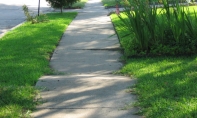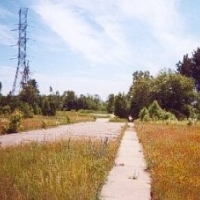- About Us
- Columns
- Letters
- Cartoons
- The Udder Limits
- Archives
- Ezy Reading Archive
- 2024 Cud Archives
- 2023 Cud Archives
- 2022 Cud Archives
- 2021 Cud Archives
- 2020 Cud Archives
- 2015-2019
- 2010-2014
- 2004-2009
 |
Sidewalks |
They are the running boards of our lives where we come and go to places of short distance. They are the children’s canvases where earliest works of  art are sketched with chalk. They are cracked and split as the years pass by, but last longer than our lifetime. Frequented by kings and queens, and yet the least of our pets will do their business on them. They are simple in design and yet can display the most intricate of patterns in their grainy texture. Both the state and citizen own them, but neither can claim the whole of them. They are sidewalks, those cemented floors that lay between house and road, between where we are and where we wish to go.
art are sketched with chalk. They are cracked and split as the years pass by, but last longer than our lifetime. Frequented by kings and queens, and yet the least of our pets will do their business on them. They are simple in design and yet can display the most intricate of patterns in their grainy texture. Both the state and citizen own them, but neither can claim the whole of them. They are sidewalks, those cemented floors that lay between house and road, between where we are and where we wish to go.
It is upon these urban paradoxes that I find myself perplexedly musing or, rather, walking and cycling on a daily basis. The inhabitants of my neighborhood are most content to busy themselves as they water their lawns, jog, or head to the park without a thought. I wonder if they ever might look down to ponder, “Where does this path go and where does it come from?” For as much as we know about sidewalks, none of us  can account for their geography, etymology or even eschatology. And while I suspect that the most imaginative of our children may fancy rainbows shooting from their very beginning point, or some pit of monsters and a stormy abyss at their end, our own answers may not fare any better. After all, we take sidewalks for granted while investing so much time on and around them. But there is a comfort to be found in their very existence.
can account for their geography, etymology or even eschatology. And while I suspect that the most imaginative of our children may fancy rainbows shooting from their very beginning point, or some pit of monsters and a stormy abyss at their end, our own answers may not fare any better. After all, we take sidewalks for granted while investing so much time on and around them. But there is a comfort to be found in their very existence.
In Shel Silverstein’s poem Where the Sidewalk Ends, he gave a rather vivid account of the sidewalk. It is where “the street begins”, where “the grass grows soft and white”, where “the sun burns crimson bright”, and where “the moon-bird rests from his flight.” But he offers nothing of as to where the sidewalk might end. And no mention either of where they begin? For where they are and where they are not must meet somewhere in the intermediary cosmos of villa to village. Is it the yawning void of Nordic Mythology where Ymir the giant gave birth to the nine worlds? Is it that purgatory in Dante’s Inferno? Or is it some Stygian realm at the foot of Elysium?
 Now while this is all magnificently spectacular speculating, let me say that where all sidewalks come from and where they end is abundantly clear: where we are all coming from and going to. They begin when we begin and end when we end. They are that part of us that we see so little of, even when thinking deeply and analyzing our own self-identity. They are the first and last of our steps. Akin to Aristotle’s definition of time, they are the before and after, but not of motion but of motivation. They are that general and abstract expression of why we do the things we do. And perhaps this is why we overlook sidewalks so. For, like us, there is infinitely more to them than meets the eye.
Now while this is all magnificently spectacular speculating, let me say that where all sidewalks come from and where they end is abundantly clear: where we are all coming from and going to. They begin when we begin and end when we end. They are that part of us that we see so little of, even when thinking deeply and analyzing our own self-identity. They are the first and last of our steps. Akin to Aristotle’s definition of time, they are the before and after, but not of motion but of motivation. They are that general and abstract expression of why we do the things we do. And perhaps this is why we overlook sidewalks so. For, like us, there is infinitely more to them than meets the eye.
